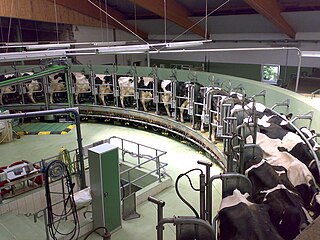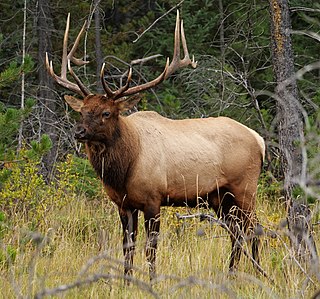
The West Coast is a region of New Zealand on the west coast of the South Island. It is administered by the West Coast Regional Council, and is known co-officially as Te Tai Poutini. It comprises the territorial authorities of Buller District, Grey District and Westland District. The principal towns are Westport, Greymouth and Hokitika. The region, one of the more remote areas of the country, is also the most sparsely populated. With a population of just 32,900 people, the West Coast is the least populous region in New Zealand. The population in the region grew by 0.4% over the year to July 2023.

The Highland is a Scottish breed of rustic cattle. It originated in the Scottish Highlands and the Western Islands of Scotland and has long horns and a long shaggy coat. It is a hardy breed, able to withstand the intemperate conditions in the region. The first herd-book dates from 1885; two types – a smaller island type, usually black, and a larger mainland type, usually dun – were registered as a single breed. It is reared primarily for beef, and has been exported to several other countries.

The Jersey is a British breed of small dairy cattle from Jersey, in the British Channel Islands. It is one of three Channel Island cattle breeds, the others being the Alderney – now extinct – and the Guernsey. The milk is high in butterfat and has a characteristic yellowish tinge.

The Aberdeen Angus, sometimes simply Angus, is a Scottish breed of small beef cattle. It derives from cattle native to the counties of Aberdeen, Banff, Kincardine and Angus in north-eastern Scotland. In 2018 the breed accounted for over 17% of the beef production in the United Kingdom.

The Holstein Friesian is an international breed or group of breeds of dairy cattle. It originated in Frisia, stretching from the Dutch province of North Holland to the German state of Schleswig-Holstein. It is the dominant breed in industrial dairy farming worldwide, and is found in more than 160 countries. It is known by many names, among them Holstein, Friesian and Black and White.

Elephant seals or sea elephants are very large, oceangoing earless seals in the genus Mirounga. Both species, the northern elephant seal and the southern elephant seal, were hunted to the brink of extinction for oil by the end of the 19th century, but their numbers have since recovered. They can weigh up to 4,000 kilograms (8,800 lb). Despite their name, elephant seals are not closely related to elephants, and the large proboscis or trunk that males have was convergently evolved.

Dairy farming is a class of agriculture for the long-term production of milk, which is processed for the eventual sale of a dairy product. Dairy farming has a history that goes back to the early Neolithic era, around the seventh millennium BC, in many regions of Europe and Africa. Before the 20th century, milking was done by hand on small farms. Beginning in the early 20th century, milking was done in large scale dairy farms with innovations including rotary parlors, the milking pipeline, and automatic milking systems that were commercially developed in the early 1990s.

The muskox is a hoofed mammal of the family Bovidae. Native to the Arctic, it is noted for its thick coat and for the strong odor emitted by males during the seasonal rut, from which its name derives. This musky odor has the effect of attracting females during mating season. Its Inuktitut name "umingmak" translates to "the bearded one".

Dairy cattle are cattle bred with the ability to produce large quantities of milk, from which dairy products are made. Dairy cattle generally are of the species Bos taurus.

The Dairy Shorthorn is a British breed of dairy cattle. It derives from the Shorthorn cattle of Teesside, in the North Riding of Yorkshire and in Northumbria in north-eastern England. The Shorthorn was for this reason at first known as the Durham or Teeswater.

Lyall's wren or the Stephens Island wren was a small, flightless passerine belonging to the family Acanthisittidae, the New Zealand wrens. Now extinct, it was once found throughout New Zealand, but when it came to the attention of scientists in 1894, its last refuge was Stephens Island in Cook Strait. Often claimed to be a species driven extinct by a single creature, the wren in fact fell victim to the island's numerous feral cats. The wren was described almost simultaneously by both Walter Rothschild and Walter Buller. It became extinct shortly thereafter.

The Belted Galloway is a traditional Scottish breed of beef cattle. It derives from the Galloway stock of the Galloway region of south-western Scotland, and was established as a separate breed in 1921. It is adapted to living on the poor upland pastures and windswept moorlands of the region. The exact origin of the breed is unclear, although the white belt for which they are named, and which distinguishes the breed from black Galloway cattle, is often surmised to be the result of cross-breeding with the similarly coloured Dutch Lakenvelder.

Luing cattle are a beef breed developed on the island of Luing in the Inner Hebrides of Scotland by the Cadzow brothers in 1947. It was formed by first crossbreeding Beef Shorthorn with Highland cattle and then breeding the resulting progeny with Beef Shorthorns to produce an animal three quarters Beef Shorthorn, one quarter Highland. The breed of red-brown cattle are moderately sized and extremely hardy. The intent was to produce a good beef cow with the ability to raise a calf under adverse weather conditions. It was officially recognised as a breed by the British government in 1965. The breed is still farmed today, mainly in Scotland but also in other areas of the world.
A carcass grade is an assessment of quality for a culled cow or bull. The various grades are defined by the United States Department of Agriculture, and assessments are based primarily on the fatness of the cow to be culled.

The elk, or wapiti, is the second largest species within the deer family, Cervidae, and one of the largest terrestrial mammals in its native range of North America and Central and East Asia. The word "elk" originally referred to the European variety of the moose, Alces alces, but was transferred to Cervus canadensis by North American colonists.

Tōgyū (闘牛), also known as ushi-zumo or bull sumo, is bull wrestling as it is called in Japan. It used to be a traditional annual or seasonal sport by the proud owners of the farming bulls, but it is now held as a spectator sport in various places, such as the prefectures of Iwate, Kagoshima, Niigata, Okinawa and Shimane.
Campbell Island cattle were a feral breed of domestic cattle found on Campbell Island, New Zealand. From photographs taken in 1976 it appeared that the cattle were at least partly of shorthorn origin. This breed is now extinct.

A bull is an intact adult male of the species Bos taurus (cattle). More muscular and aggressive than the females of the same species, bulls have long been an important symbol in many religions, including for sacrifices. These animals play a significant role in beef ranching, dairy farming, and a variety of sporting and cultural activities, including bullfighting and bull riding.
The water bull, also known as tarbh-uisge in Scottish Gaelic, is a mythological Scottish creature similar to the Manx tarroo ushtey and the Irish tarbh-uisce. Generally regarded as a nocturnal resident of moorland lochs, it is usually more amiable than its equine counterpart the water horse, but has similar amphibious and shapeshifting abilities.
















